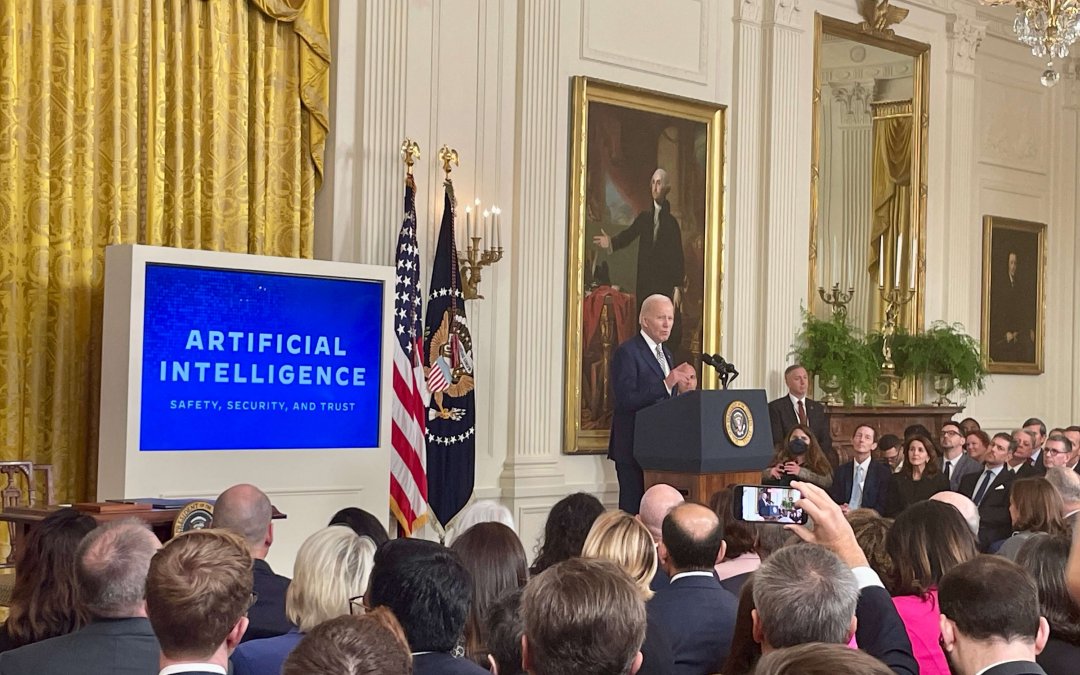WASHINGTON – President Joe Biden signed a long-anticipated executive order on artificial intelligence Monday, marking the federal government’s most comprehensive effort to rein in the technology to date.
“One thing is clear: to realize the promise of AI and avoid the risks, we need to govern this technology, and there’s no other way around it,” Biden said during the signing ceremony.
The executive order expanded upon a “Blueprint for an AI Bill of Rights” the Biden administration issued in 2022. The document calls for the development and implementation of AI systems to follow five principles, including safety, protection against discrimination and data privacy, and to ensure civil liberties and democratic values.
A significant proportion of the executive order is on implementing guardrails to address the security risks AI poses. Wielding the Defense Production Act, a Korean War-era legislation that authorizes the president to establish regulations to promote national defense, the order requires private companies to share safety test results on new, advanced AI models with the federal government before these models can be released to the public.
In a briefing call with reporters ahead of the executive order, a senior Biden administration official said the requirement will only apply to models that reach a certain capability threshold, and they do not expect the requirement to affect any AI model currently on the market, nor is the administration contemplating restricting or removing existing AI systems.
The order also directs the Department of Commerce to craft guidelines on authenticating and watermarking AI-generated content, with a particular emphasis on fabricated photos, audio and videos. With the 2024 presidential election fast approaching, election officials and experts have warned that AI-generated content – sometimes known as deepfakes – has the potential to significantly disrupt campaigns and reduce the public’s trust in election integrity.
Additionally, the executive order touches on key aspects of the U.S. economy that AI technology would impact. It directs federal agencies to develop guidelines on addressing the risks AI poses to the industries and sectors they regulate, while identifying potential benefits of the new technology. Most agencies will have between 90 and 270 days to complete the new guidelines and policies the executive order assigned, before the next presidential administration.
For example, the order instructs the Department of Housing and Urban Development and the Consumer Financial Protection Bureau to issue guidance on preventing algorithmic discrimination in housing and credit. The Department of Labor is instructed to draw up principles and best practices for mitigating AI’s impact on job displacement. And the Department of Education is tasked with developing resources for educators to implement AI-powered tools in the classroom.
The order specifically encourages the Federal Trade Commission, which has just filed an antitrust suit against Amazon for maintaining a monopoly in online retail, to police anticompetitive practices in the AI technology market.
The executive order is “the next step in an aggressive strategy to do everything on all fronts to harness the benefits of AI and mitigate the risks,” said White House Deputy Chief of Staff Bruce Reed.
Although the executive order does not carry the same force of law as an act of Congress, its directives to federal agencies would allow them to influence the market for AI technology as both regulators and consumers of those technologies.
At the same time, Congress has been playing catch up to act on AI regulation. A large repertoire of legislation seeking to govern various aspects of the fast-evolving technology is now in different stages of the legislative pipeline.
Majority Leader Chuck Schumer (D-N.Y.), who attended the signing ceremony, has also hosted two “AI Insight Forums” that brought together senators, tech and civil society leaders and AI experts, with more in the planning.
However, Schumer has signaled that a comprehensive AI bill is unlikely to be introduced until next year, and following the ceremony, he told reporters that the legislation will be ready in the coming months.
During the signing ceremony Monday, Biden again urged Congress to pass bipartisan legislation on AI. He said he will meet with Schumer and a group of senators across the aisle on Tuesday to discuss legislative actions.
The announcement came two days ahead of a major international summit on AI safety hosted by the United Kingdom, where Vice President Kamala Harris will pitch the executive order as the standard for AI regulation globally. The president is also expected to travel to the Asia-Pacific Economic Cooperation summit in San Francisco, where he will have a face-to-face meeting with Chinese President Xi Jinping.
The UK government recently came under fire for inviting China to the summit, which is a major player in creating advanced AI technology, a development the U.S. is attempting to curb, and has outpaced the U.S. in rolling out detailed AI regulation.
While the Biden administration has expressed concerns about China’s use of AI technology to modernize its military and to surveil and repress its citizens, a senior administration official said they are open to cooperating with China on this issue.
“We are willing to work with a wide range of countries, including China, on questions of AI safety and security and governance, while still remaining steadfast in our values and our perspective,” the official said.


